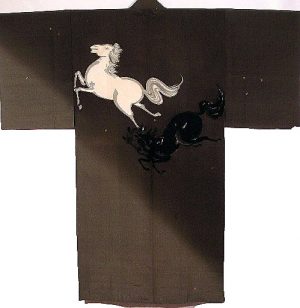Description
(True color photo below). In Japan’s past, the rules for dress were every bit as rigid as those for other aspects of society. In the Edo Era (1615-1867) and Meiji Eras (1867-1912), women were not allowed to wear the gauze silks except in 3 summer months. This is a very old, hand woven and rare transparent Silk Gossamer Kimono. This style of Kimono is called a “Furisode,” or “swinging sleeves,” and it is the length of the sleeve, literally, that determine the age, the amount of brighter colors incorporated in the garment, and the marital status of a woman in Japan who could wear it. Thus, this textile treasure was intended to be worn by a young, unmarried woman in June, July, and/or August. This exceptional Kimono is “Ro” Silk. It has been hand woven (including the use of pure white gold threads for high lights), hand dyed, and hand stenciled using natural dyes.
This design was obviously intended for late summer, and meant to give an cool feeling at the hottest time of the year. This particular motif gives a light and airy feeling through its use of color, its depiction of cool green grasses blowing in the breeze and the unusual inclusion of the fragile, darting Dragonfly (“Tombo”). The Dragonfly, as a design motif, is one of the oldest of Japanese designs. It appeared on bronze bells as early as the Yayoi Period (ac. 200 B.C. – A.D. 200) In ancient Japanese classical texts, the Dragonfly is called “Akizu,” in reference to Yamato, the name of the ancient islands of Japan. Traditionally, small Dragonflies were shown flitting delicately over the water as part of a late summer scene. Here, the Dragonflies are the commanding images, typical of bold Taisho Era designs (1912-1926), although this modern appearance was created during the Meiji Era for a forward looking, fashionable young woman.
Separated by the swirling grasses and dynamic purple lines (a color confined to the use of royalty), these Dragonfly resemble those of medieval days, as it was referred to then as a victory insect (“Kachi Mushi”) while its beautiful form decorated Samurai Armor. This image is reinforced by the large size of the pictured Dragonflies as they dominated the design. Additionally, the Dragonfly motif has carried weighty connotations throughout much of Japanese History, which is in direct contrast to its fragile nature.
The Dragonfly is a fitting symbol for summer fare and helps unite the grass filled and striped columns. The freshness of this motif created the illusion of shading which was accomplished through variations in the widths of lines in both the sprays of grass and striped lines that invite the Dragonfly. Only a young woman of nobility and great wealth could have worn a garment of this quality for only 3 months of the year.
A Certificate of Authenticity is included.
TTAC will personally pack and ship via UPS at company expense within the continental U.S.








